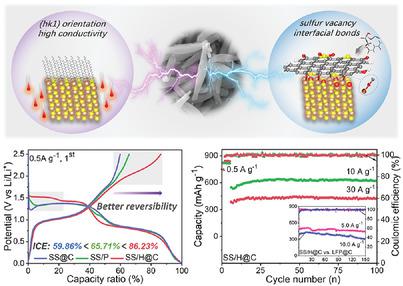当前位置:
X-MOL 学术
›
Adv. Funct. Mater.
›
论文详情
Our official English website, www.x-mol.net, welcomes your feedback! (Note: you will need to create a separate account there.)
Tailoring Rational Crystal Orientation and Tunable Sulfur Vacancy on Metal-Sulfides toward Advanced Ultrafast Ion-Storage Capability
Advanced Functional Materials ( IF 19.0 ) Pub Date : 2022-11-28 , DOI: 10.1002/adfm.202211542 Wenqing Zhao 1, 2 , Shaohui Yuan 1 , Shuya Lei 1 , Zihao Zeng 1 , Jinfeng Dong 1, 2 , Feng Jiang 1 , Yue Yang 1 , Wei Sun 1 , Xiaobo Ji 3 , Peng Ge 1
Advanced Functional Materials ( IF 19.0 ) Pub Date : 2022-11-28 , DOI: 10.1002/adfm.202211542 Wenqing Zhao 1, 2 , Shaohui Yuan 1 , Shuya Lei 1 , Zihao Zeng 1 , Jinfeng Dong 1, 2 , Feng Jiang 1 , Yue Yang 1 , Wei Sun 1 , Xiaobo Ji 3 , Peng Ge 1
Affiliation

|
Attracted by high energy density and power density, metal-sulfides anodes have promising application prospects in fast charging batteries. However, they still suffer from low electrical conductivity and sluggish electrochemical kinetics, resulting in poor fast charging capacity. Herein, spindle-like antimony sulfide (Sb2S3) is rationally tailored with favorable (hk1) crystal orientation and rich S-vacancies using a simple hydrothermal method, which improve electric conductivity significantly. Triggered by S-vacancies lattice defects, SbOC interfacial bonds and S-doped carbon layer are built successfully. Under their multiple-controlling synergistic effects, electrochemical kinetics and reaction reversibility are promoted effectively. As expected, Sb2S3/HTAB@C show high average initial coulombic efficiency of 86.12%, and deliver 624.5 and 428.4 mAh g−1 after cycling 100 cycles at 10.0 and 30.0 A g−1 respectively in Li-ion batteries (LIBs). Electrochemical kinetic analysis and theoretical calculations indicate that superior ultrafast charging capacity originates from quickened interfacial electron/ions transferring and alleviates electrochemical polarization. Ex situ technologies powerfully prove good stability of (hk1) orientation, SbOC bonds and S-doped carbon layer. Notably, full LIBs of SS/H@C versus LiFePO4@C display 500.9 and 398.3 mAh g−1 at 5.0 and 10.0 A g−1, respectively. This study is anticipated to open avenue to develop advanced metal-sulfides anodes for fast charging batteries.
中文翻译:

调整金属硫化物上的合理晶体取向和可调硫空位以实现先进的超快离子存储能力
受高能量密度和功率密度的吸引,金属硫化物负极在快速充电电池中具有广阔的应用前景。然而,它们仍然存在低电导率和缓慢的电化学动力学,导致快速充电能力较差。在此,纺锤状硫化锑 (Sb 2 S 3 ) 通过简单的水热法合理地调整为具有良好的 (hk1) 晶向和丰富的S空位,显着提高了导电性。由S空位晶格缺陷、Sb O C 界面键和S触发-掺杂碳层构建成功。在它们的多重调控协同作用下,有效促进了电化学动力学和反应可逆性。正如预期的那样,Sb 2 S 3 /HTAB@C在锂离子电池(LIBs)中分别以 10.0 和 30.0 A g -1循环 100 个循环后显示出 86.12% 的高平均初始库仑效率,并提供 624.5 和 428.4 mAh g -1 ). 电化学动力学分析和理论计算表明,优异的超快充电容量源于界面电子/离子转移的加速和电化学极化的减轻。非原位技术有力地证明了 (hk1) 取向的良好稳定性,Sb O C键和S掺杂的碳层。值得注意的是,SS/H@C 与 LiFePO 4 @C 的完整 LIB在 5.0 和 10.0 A g -1时分别显示 500.9 和 398.3 mAh g -1 。这项研究有望为开发用于快速充电电池的先进金属硫化物阳极开辟道路。
更新日期:2022-11-28
中文翻译:

调整金属硫化物上的合理晶体取向和可调硫空位以实现先进的超快离子存储能力
受高能量密度和功率密度的吸引,金属硫化物负极在快速充电电池中具有广阔的应用前景。然而,它们仍然存在低电导率和缓慢的电化学动力学,导致快速充电能力较差。在此,纺锤状硫化锑 (Sb 2 S 3 ) 通过简单的水热法合理地调整为具有良好的 (hk1) 晶向和丰富的S空位,显着提高了导电性。由S空位晶格缺陷、Sb O C 界面键和S触发-掺杂碳层构建成功。在它们的多重调控协同作用下,有效促进了电化学动力学和反应可逆性。正如预期的那样,Sb 2 S 3 /HTAB@C在锂离子电池(LIBs)中分别以 10.0 和 30.0 A g -1循环 100 个循环后显示出 86.12% 的高平均初始库仑效率,并提供 624.5 和 428.4 mAh g -1 ). 电化学动力学分析和理论计算表明,优异的超快充电容量源于界面电子/离子转移的加速和电化学极化的减轻。非原位技术有力地证明了 (hk1) 取向的良好稳定性,Sb O C键和S掺杂的碳层。值得注意的是,SS/H@C 与 LiFePO 4 @C 的完整 LIB在 5.0 和 10.0 A g -1时分别显示 500.9 和 398.3 mAh g -1 。这项研究有望为开发用于快速充电电池的先进金属硫化物阳极开辟道路。


























 京公网安备 11010802027423号
京公网安备 11010802027423号